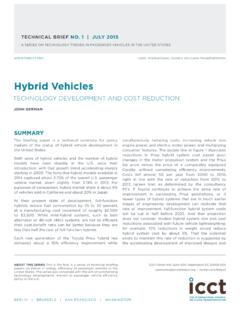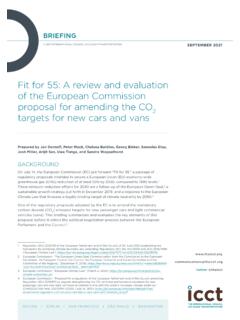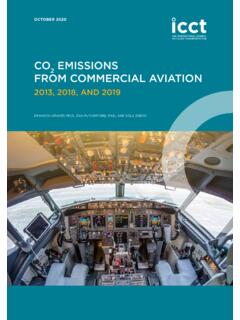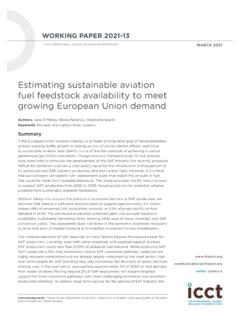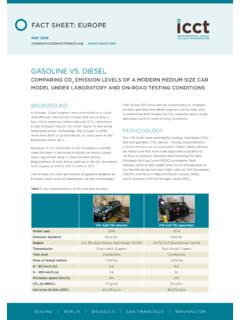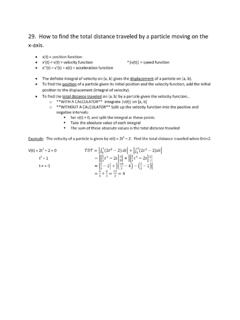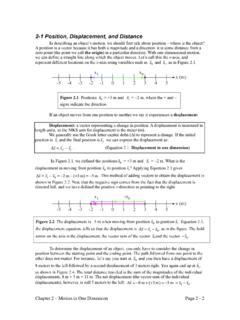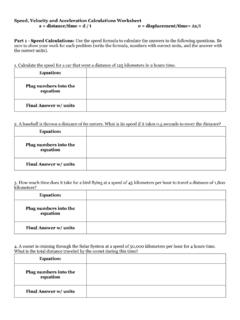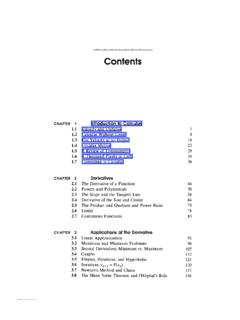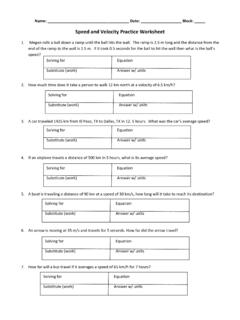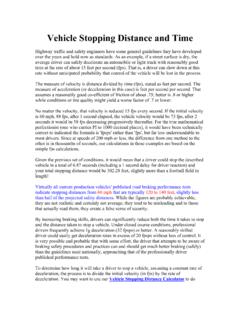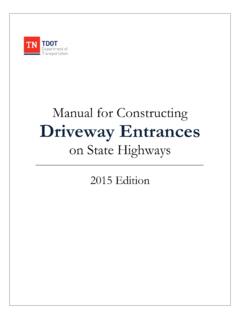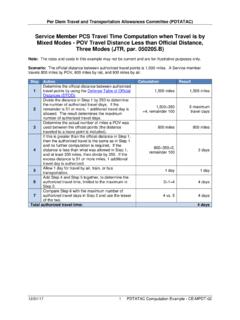Transcription of CO2 emissions from commercial aviation, 2018
1 INTERNATIONAL COUNCIL ON CLEAN TRANSPORTATION, 2019CO2 emissions from commercial aviation, 2018 Authors: Brandon Graver, , Kevin Zhang, Dan Rutherford, Date: September 2019 Keywords: aviation; aircraft; fuel efficiency; carbon dioxideSUMMARYG reenhouse gas emissions from commercial aviation are rapidly in-creasing, as is interest among fliers in reducing their carbon footprints. Under a business-as-usual trajecto-ry, the United Nations International Civil Aviation Organization (ICAO) expects aviation emissions to roughly triple by 2050, at which time aircraft might account for 25% of the global carbon budget. Although ICAO and the International Air Transport Association (IATA) publish annual summary statistics of aircraft operations and econom-ics, respectively, relatively little data is available about fuel burn, fuel ef-ficiency, and carbon emissions at the regional and national levels.
2 Policymakers cannot determine the precise amount of carbon emissions associated with flights departing from individual countries, nor can they distinguish the proportion of emissions from passenger- and-freight and all-freight op-erations, or from domestic and international flights. To better understand carbon emis-sions associated with commercial aviation, this paper develops a bottom-up, global aviation CO2 in-ventory for calendar year historical data from OAG Aviation Worldwide Limited, national governments, international agencies, and the Piano aircraft emissions mod-elling software, this paper details a global, transparent, and geographi-cally allocated CO2 inventory for commercial aviation.
3 Our estimates of total global carbon emissions , and the operations estimated in this study in terms of revenue passenger kilometers (RPKs) and freight tonne kilometers (FTKs), agree well with aggregate industry estimates. Nearly 39 million flights from 2018 were analyzed, and 38 million of these were flown by passenger aircraft. total CO2 emissions from all commercial opera-tions, including passenger movement, belly freight, and dedicated freight, totaled 918 million metric tons (MMT) in 2018. That is of global CO2 emissions from fossil fuel use and a 32% increase over the past five years. Further, this emissions growth rate is 70% higher than assumed under cur-rent ICAO data shows that passenger transport accounted for 747 MMT, or 81%, of total emissions from com-mercial aviation in 2018.
4 Globally, two-thirds of all flights were do-mestic, and these accounted for approximately one-third of global RPKs and 40% of global passenger transport-related CO2 emissions . On a national level, flights depart-ing airports in the United States and its territories emitted almost one-quarter (24%) of global passenger transport-related CO2, and two-thirds of those emissions came from do-mestic flights. The top five countries for passenger aviation-related car-bon emissions were rounded out by China, the United Kingdom, Japan, and Germany. CO2 emissions from aviation were distributed unequally across nations; less developed coun-tries that contain half of the world s population accounted for only 10% of all paper also apportions 2018 emissions by aircraft class and stage length.
5 Passenger movement in nar-rowbody aircraft was linked to 43% of aviation CO2, and passenger emis-sions were roughly equally divided between short-, medium-, and long-haul operations. The carbon intensity of flights averaged between 75 and 95 grams (g) of CO2 per RPK, rising to almost 160 g CO2/RPK for regional flights less than 500 kilometers. BACKGROUNDG reenhouse gas emissions from com-mercial aviation are rapidly increasing. If the global aviation sector were treated as a nation, it would have been WORKING PAPER 2019-16 Acknowledgments: We thank Sola Zheng for her assistance in preparing the data file and graphics associated with this paper, and Dale Hall, Jennifer Callahan, Joe Schultz, Annie Petsonk, and Bill Hemmings for providing constructive feedback on an initial draft.
6 This work was conducted with generous support from the Aspen Global Change emissions FROM commercial AVIATION, 2018 2 INTERNATIONAL COUNCIL ON CLEAN TRANSPORTATION WORKING PAPER 2019-16the sixth-largest source of carbon di-oxide (CO2) emissions from energy consumption in 2015, emitting more than Germany (Air Transport Action Group [ATAG], 2019; Olivier, Janssens-Maenhout, Muntean, & Peters, 2016). The International Civil Aviation Organization (ICAO), the United Nations organization with author-ity over global aviation, expects CO2 emissions from international aviation to approximately triple by 2050 if cur-rent trends hold (ICAO, 2019a). If other sectors decarbonize in line with the Paris Agreement s climate ambitions, aviation could account for one-quarter of the global carbon budget by mid-century (Pidcock & Yeo, 2016).
7 In 2009, the International Air Transport Association (IATA), the global trade association for cargo and passenger air carriers, set three goals for reducing CO2 emissions from aviation: (1) an average improve-ment in fuel efficiency of per year from 2009 to 2020; (2) a limit on net aviation CO2 emissions after 2020 ( , carbon-neutral growth); and (3) a 50% reduction in net aviation CO2 emissions by 2050, relative to 2005 levels (IATA, 2018a). According to industry estimates, global CO2 emis-sions from the airline industry were 862 million metric tonnes (MMT) in 2017, and fuel efficiency has improved by per year since 2009 (ATAG, 2019).1 For 2018, IATA (2019) esti-mated 905 MMT of CO2 from global aviation, an increase of from its 2017 estimate of 860 MMT of values that groups like IATA and ATAG provide annually only give the public a single data point with respect to fuel burn, fuel effi-ciency, and carbon emissions .
8 ICAO (2019b) provides RPK and FTK data by country and geographic region, and breaks down global scheduled services into domestic and inter-national operations. What remains 1 Measured in terms of revenue tonne kilometers (RTKs) transported per liter of fuel. Compounded annually, RTKs have increased by since 2009, while fuel use has increased by 4% over the same time period. See ATAG (2019).largely unavailable, though, is ad-ditional texture about the data, including details of emissions based on where flights originate, emissions from domestic versus international travel, and the proportion of emis-sions from passenger-and-freight and all-freight operations. To help, this paper details ICCT s compila-tion of a new data set and uses that data to analyze the geographic distribution of CO2 emissions from commercial aviation.
9 It also relates emissions to operational variables like aircraft class and stage publicly available data sources were acquired and merged to quantify commercial fuel con-sumption using Piano 5, an aircraft performance and design software from Lissys The data obtained concerned airline operations, air-ports, and demand, as detailed below. From that we modeled fuel burn and estimated CO 2 emissions , and then validated the results. AIRLINE OPERATIONS DATABASEG lobal airline operations data for cal-endar year 2018 was sourced from OAG Aviation Worldwide Limited (OAG). The OAG dataset contained the following variables for passenger and cargo airlines: air carrier, departure airport, arrival airport, aircraft type, and departures (number of flights).
10 Operations data for cargo carriers DHL, FedEx, and UPS was not avail-able from OAG due to restrictions put in place by the companies. To com-pensate, we utilized alternate data sources to identify the fuel burn asso-ciated with these carriers operations (Deutsche Post DHL Group, 2019; Department of Transportation [DOT], 2019). All of these sources were combined to create our new Airline Operations Database. General and military aviation, which likely accounted for 10% or less of 2 aviation CO2 in 2018, are both be-yond the scope of this The non-CO2 climate impacts of com-mercial aviation linked to emissions of nitrogen oxides, black carbon, and aviation-induced cloudiness were likewise not GLOBAL AIRPORTS DATABASEWe created a Global Airports Database, a database with geograph-ic information for all of the airports included in the Airline Operations Database.

